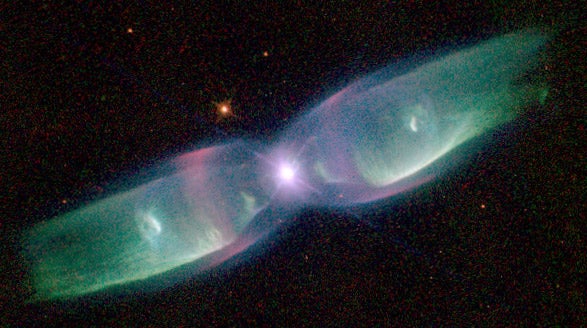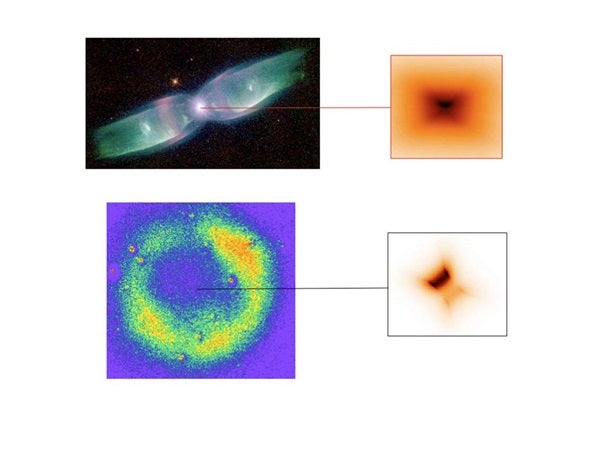Astronomers from the University of Manchester’s Jodrell Bank Center for Astrophysics and the Observatoire de la Cote d’Azur in France have used the Very Large Telescope (VLT) in Chile to discover disks of dust around aging stars. The images were presented by Foteini (Claire) Lykou Wednesday, April 14 at the Royal Astronomical Society’s National Astronomy Meeting (NAM2010) in Glasgow.
“This is the first time we have ever observed in these dusty disks in such detail,” said Lykou.
Toward the end of its life, in around 5 billion years time, our Sun will evolve into a red giant star. The temperature near the core will rise, and the outer layers will expand to form a tenuous atmosphere a few hundred times the current radius of the Sun. Dust, which forms in this cool atmosphere, along with gas, is expelled from these types of stars during the aging process and forms the raw materials for the next generations of stars and planets. As the dust flows out into space, it is shaped into beautiful nebulae by mechanisms that are not yet fully understood. Dusty disks can be created as a by-product of those mechanisms. Ultimately, nuclear fusion shuts down, and the core of the dead star becomes a white dwarf.
Although these dusty disks are more than a hundred thousand million kilometers across (almost a thousand times larger than the orbit of the Earth around the Sun), they lie at such large distances from us that their apparent size is tiny. Scientists can only observe the disks using a special technique in which telescopes are combined together to act like a giant zoom lens, dramatically increasing the sharpness of view.
The astronomers used the Very Large Telescope Interferometer (VLTI) at the European Southern Observatory in Chile. This combines four giant telescopes, each with an 8.2-meter mirror, to create a telescope with the sharpness of view of one with a diameter of up to 130 meters. The VLTI also has the advantage of observing in the infrared, the part of the electromagnetic spectrum where the dusty discs shine brightly.
The first disk was found in M2-9, a bipolar nebula (a gas cloud with symmetrical lobes) 4,200 light-years away that has a binary stellar system in its core. Both stars, a red giant and a white dwarf, are hidden inside the disk. The dust originates from the red giant, which is 27,000° Fahrenheit (15,000° Celsius) and 2,500 times more luminous than the Sun.
The disk has an inner radius of 1400 million miles (2250 million kilometers) and an outer radius near 84 thousand million miles (135 thousand million km) and is composed of dust grains made out of silicon and oxygen, similar to the dust found in our solar system.
“The disk inside M2-9 is probably less than 2,000 years old, making it a teenager in terms of the lifetime of these disks,” Lykou said. “It is still evolving due to the gravitational interactions of the binary stars.”
Scientists found the second disk in Sakurai’s Object, a round nebula that lies 11,400 light-years from Earth. The star is 21,600° F (12,000° C) and 10,000 times brighter than the Sun. It is composed of amorphous carbon, a type of carbon that has no crystalline structure (coal and soot have this composition) and it is growing in size.
“The disk in Sakurai’s Object was created within the last 10 years, so we have the opportunity to study a newborn disc,” Lykou said. “It is expanding radially — and rapidly — in space. During our observation period in 2007, we saw the disk extend from 10 thousand million kilometers [6.2 thousand million miles] to 75 thousand million kilometers [47 thousand million miles].”
The most probable scenario for the distant future is that the disks may be destroyed by interstellar radiation breaking down the dust grains to their individual atoms and molecules, thus replenishing and enriching the galaxy’s interstellar medium with new materials.











